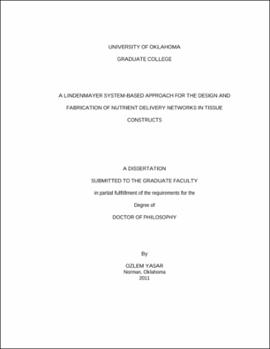| dc.contributor.advisor | Starly, Dr. Binil | |
| dc.creator | Yasar, Ozlem | |
| dc.date.accessioned | 2019-04-27T21:33:02Z | |
| dc.date.available | 2019-04-27T21:33:02Z | |
| dc.date.issued | 2011 | |
| dc.identifier | 99292665702042 | |
| dc.identifier.uri | https://hdl.handle.net/11244/318986 | |
| dc.description.abstract | A Lindenmayer System-Based Approach for the Design and Fabrication of Nutrient Delivery Networks in Tissue Constructs for Maskless Photolithography | |
| dc.description.abstract | Ozlem Yasar | |
| dc.description.abstract | Binil Starly, Ph.D | |
| dc.description.abstract | Remarkable advances in the fields of biomedical engineering, material science, molecular biology and biochemistry have made contributions for the cross-disciplinary field of tissue engineering. The field of tissue engineering applies the engineering and the life sciences principles to seek man-made replacements for damaged tissue or whole organs. Porous scaffolds are considered as the key components of tissue engineering because in the regenerative process porous scaffolds guide cells for attachment, proliferation and differentiation in the desired tissue. In today's technology, large thick tissue constructs have reported limited success primarily due to the inability of cells to survive deep within the scaffold. On the other hand, without access to adequate nutrients, cells placed deep within the tissue construct will die out, leading to non-uniform tissue regeneration. Currently, there is a necessity to design nutrient conduit networks within the tissue construct to enable cells to survive in the matrix. However, the design and fabrication of complex networks within a tissue construct is a challenging process. | |
| dc.description.abstract | In this work, we have explored the use of Lindenmayer Systems (L-Systems), a fractal-based language algorithm framework, to generate nutrient conduit networks in two and three-dimensional architecture with several degrees of complexity. The architecture is based on a set of pre-determined axioms and production rules that guide the growth of the conduit networks. The conduit network maintains a parent-child relationship between each branch of the network. This thesis reports research addressing some of the challenges and proposed solutions in applying the Lindenmayer Systems for the design and freeform fabrication of tissue scaffolds with inbuilt network branches. In addition, we present a maskless photopolymerization based layered manufacturing concept to fabricate the L-System networks in polymeric hydrogels. The major research accomplishments reported in this thesis include: | |
| dc.description.abstract | i.Development of the Lindenmayer Systems to generate pre-designed nutrient branched networks within the scaffold architecture | |
| dc.description.abstract | ii.Development of a Digital Light Processing (DLP) setup based on a layered manufacturing photopolymerization system to realize the designed architecture at multiple scales | |
| dc.description.abstract | Lindenmayer Systems enable many novel approaches in modeling and design of complex branching network systems for tissue scaffolds to provide sufficient nutrients distribution for the cells. DLP based layered fabrication also enables researchers to realize precise control of internal architecture design of scaffolds. Since existing design and fabrication techniques lack sufficient nutrient and oxygen delivery deep into the thick scaffolds, we believe that this research will make significance contributions to scaffold based tissue engineering and regenerative medicine. Future research efforts will be undertaken to explore the development of parametric L-System axioms and rules through the use of pre-defined growth functions which allow the branch structure to grow based on the external availability of nutrients and initial input conditions. The goal would be to design scaffold internal architecture designs which take into account manufacturing process constraints while allowing maximal control on the growth of the branched networks. It is hoped that by providing complex internal patterns that mimic the cellular structure, cells can be guided to form the intended structure. On the manufacturing front, the system will need to be automated to provide a fully integrated SFF system capable of repeatable and stable fabrication process through accurate modeling and control of the various fabrication parameters. | |
| dc.format.extent | 101 pages | |
| dc.format.medium | application.pdf | |
| dc.language | en_US | |
| dc.relation.requires | Adobe Acrobat Reader | |
| dc.subject | L systems | |
| dc.subject | Tissue engineering | |
| dc.subject | Tissue scaffolds | |
| dc.title | A LINDENMAYER SYSTEM-BASED APPROACH FOR THE DESIGN AND FABRICATION OF NUTRIENT DELIVERY NETWORKS IN TISSUE CONSTRUCTS | |
| dc.type | text | |
| dc.type | document | |
| dc.thesis.degree | Ph.D. | |
| ou.group | College of Engineering::School of Industrial Engineering | |
